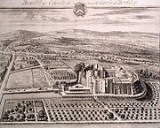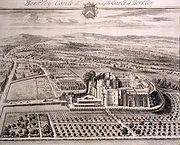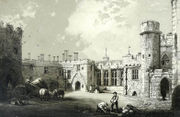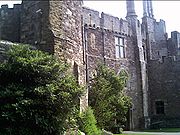
Berkeley Castle
Encyclopedia

Castle
A castle is a type of fortified structure built in Europe and the Middle East during the Middle Ages by European nobility. Scholars debate the scope of the word castle, but usually consider it to be the private fortified residence of a lord or noble...
in the town of Berkeley
Berkeley, Gloucestershire
Berkeley is a town and civil parish in Gloucestershire, England. It lies in the Vale of Berkeley between the east bank of the River Severn and the M5 motorway within the Stroud administrative district. The town is noted for Berkeley Castle where the imprisoned Edward II was murdered.- Geography...
, Gloucestershire
Gloucestershire
Gloucestershire is a county in South West England. The county comprises part of the Cotswold Hills, part of the flat fertile valley of the River Severn, and the entire Forest of Dean....
, UK
United Kingdom
The United Kingdom of Great Britain and Northern IrelandIn the United Kingdom and Dependencies, other languages have been officially recognised as legitimate autochthonous languages under the European Charter for Regional or Minority Languages...
. The castle's origins date back to the 11th century and it has been designated by English Heritage
English Heritage
English Heritage . is an executive non-departmental public body of the British Government sponsored by the Department for Culture, Media and Sport...
as a grade I listed building.
The castle has remained within the Berkeley family
Berkeley family
The Berkeley family has an unbroken male line of descent from a Saxon ancestor before the Norman conquest of England in 1066 to the present day.-History:...
since they reconstructed it in the 12th century, except for a period of royal ownership by the Tudors
Tudor dynasty
The Tudor dynasty or House of Tudor was a European royal house of Welsh origin that ruled the Kingdom of England and its realms, including the Lordship of Ireland, later the Kingdom of Ireland, from 1485 until 1603. Its first monarch was Henry Tudor, a descendant through his mother of a legitimised...
. It was traditionally the scene of the murder of King Edward II
Edward II of England
Edward II , called Edward of Caernarfon, was King of England from 1307 until he was deposed by his wife Isabella in January 1327. He was the sixth Plantagenet king, in a line that began with the reign of Henry II...
in 1327.
Construction
The first castle at Berkeley was a motte-and-baileyMotte-and-bailey
A motte-and-bailey is a form of castle, with a wooden or stone keep situated on a raised earthwork called a motte, accompanied by an enclosed courtyard, or bailey, surrounded by a protective ditch and palisade...
, built around 1067 by William FitzOsbern
William Fitzosbern, 1st Earl of Hereford
William FitzOsbern , Lord of Breteuil, in Normandy, was a relative and close counsellor of William the Conqueror and one of the great magnates of early Norman England...
shortly after the Conquest
Norman conquest of England
The Norman conquest of England began on 28 September 1066 with the invasion of England by William, Duke of Normandy. William became known as William the Conqueror after his victory at the Battle of Hastings on 14 October 1066, defeating King Harold II of England...
. This was subsequently held by three generations of the first Berkeley family, all called Roger de Berkeley, and rebuilt by them in the first half of the 12th century. The last Roger de Berkeley was dispossessed in 1152 for withholding his allegiance from the House of Plantagenet
House of Plantagenet
The House of Plantagenet , a branch of the Angevins, was a royal house founded by Geoffrey V of Anjou, father of Henry II of England. Plantagenet kings first ruled the Kingdom of England in the 12th century. Their paternal ancestors originated in the French province of Gâtinais and gained the...
during the conflict of The Anarchy
The Anarchy
The Anarchy or The Nineteen-Year Winter was a period of English history during the reign of King Stephen, which was characterised by civil war and unsettled government...
, and the Lordship of Berkeley was then granted to Robert Fitzharding
Robert Fitzharding
Robert Fitzharding was an Englishman from Bristol who rose to the feudal barony of Berkeley and founded the family which still holds Berkeley Castle in Gloucestershire, the castle whose construction he started...
, a wealthy burgess of Bristol
Bristol
Bristol is a city, unitary authority area and ceremonial county in South West England, with an estimated population of 433,100 for the unitary authority in 2009, and a surrounding Larger Urban Zone with an estimated 1,070,000 residents in 2007...
and supporter of the Plantagenets. He was the founder of the Berkeley family which still holds the castle.
In 1153–54 Fitzharding received a royal charter
Charter
A charter is the grant of authority or rights, stating that the granter formally recognizes the prerogative of the recipient to exercise the rights specified...
from King Henry II
Henry II of England
Henry II ruled as King of England , Count of Anjou, Count of Maine, Duke of Normandy, Duke of Aquitaine, Duke of Gascony, Count of Nantes, Lord of Ireland and, at various times, controlled parts of Wales, Scotland and western France. Henry, the great-grandson of William the Conqueror, was the...
giving him permission to rebuild the castle, with the aim of defending the Bristol - Gloucester
Gloucester
Gloucester is a city, district and county town of Gloucestershire in the South West region of England. Gloucester lies close to the Welsh border, and on the River Severn, approximately north-east of Bristol, and south-southwest of Birmingham....
Road, the Severn
River Severn
The River Severn is the longest river in Great Britain, at about , but the second longest on the British Isles, behind the River Shannon. It rises at an altitude of on Plynlimon, Ceredigion near Llanidloes, Powys, in the Cambrian Mountains of mid Wales...
estuary and the Welsh
Wales
Wales is a country that is part of the United Kingdom and the island of Great Britain, bordered by England to its east and the Atlantic Ocean and Irish Sea to its west. It has a population of three million, and a total area of 20,779 km²...
border. Fitzharding built the circular shell keep
Shell keep
A shell keep is a style of medieval fortification, best described as a stone structure circling the top of a motte.In English castle morphology, shell keeps are perceived as the successors to motte-and-bailey castles, with the wooden fence around the top of the motte replaced by a stone wall...
during 1153–56, probably on the site of the former motte. The building of the curtain wall
Curtain wall (fortification)
A curtain wall is a defensive wall between two bastions of a castle or fortress.In earlier designs of castle the curtain walls were often built to a considerable height and were fronted by a ditch or moat to make assault difficult....
followed, probably during 1160–90 by Robert and then by his son Maurice.
Much of the rest of the castle is 14th century and was built for Thomas de Berkeley, 3rd Baron Berkeley
Thomas de Berkeley, 3rd Baron Berkeley
Thomas de Berkeley , aka Thomas the Rich, was an English baron and the custodian of the Berkeley Castle.He was the son of Maurice de Berkeley, 2nd Baron Berkeley and Eve la Zouche.-Edward II:...
: Thorpe's Tower, to the north of the keep, the inner gatehouse
Gatehouse
A gatehouse, in architectural terminology, is a building enclosing or accompanying a gateway for a castle, manor house, fort, town or similar buildings of importance.-History:...
to its southwest, and other buildings of the inner bailey
Ward (fortification)
In fortifications, a bailey or ward refers to a courtyard enclosed by a curtain wall. In particular, an early type of European castle was known as a Motte-and-bailey. Castles can have more than one ward. Their layout depends both on the local topography and the level of fortification technology...
.
Murder of Edward II
The castle was ransacked in 1326 by the forces of Hugh Despenser, the favourite of King Edward II. In 1327, Edward was deposed by the QueenIsabella of France
Isabella of France , sometimes described as the She-wolf of France, was Queen consort of England as the wife of Edward II of England. She was the youngest surviving child and only surviving daughter of Philip IV of France and Joan I of Navarre...
and her ally Roger Mortimer, and they made Thomas de Berkeley and his brother-in-law John Maltravers his joint custodians. They brought Edward to Berkeley Castle, and held him there for 5 months from April to September. During that time a band of Edward's supporters attacked, entered the castle and rescued him, only for him to be recaptured soon afterwards. It is possible that his captors then moved him around between several castles to make further rescue more difficult, before returning him to Berkeley Castle in September. Some commentators have claimed that Edwards' escape was actually successful, and that someone else was later murdered in his place.
Edward was reputedly murdered there on September 21, 1327 by unknown means, although popular stories of a red hot poker or suffocation persist. The cell where he is supposed to have been imprisoned and murdered can still be seen, along with the adjacent 11 m (36 ft) deep dungeon, which supposedly echoes the events of the murder every year on September 21.
The account given to Parliament
Parliament of England
The Parliament of England was the legislature of the Kingdom of England. In 1066, William of Normandy introduced a feudal system, by which he sought the advice of a council of tenants-in-chief and ecclesiastics before making laws...
at the time was simply that Edward had met with a fatal accident. The body was embalmed and remained lying in state at Berkeley for a month, in the Chapel of St John within the castle keep, before Thomas de Berkeley escorted it to Gloucester Abbey
Gloucester Abbey
Gloucester Abbey was a Benedictine abbey for monks in the city of Gloucester, England. The abbey was founded about 1022 and was dedicated to Saint Peter. It is recorded that the abbey lost about a quarter of its complement of monks in 1377 due to the Black Death.In 1540, the abbey was dissolved by...
for burial. Thomas was later charged with being an accessory to the murder, but his defence was that it was carried out by the agents of Roger Mortimer while he was away from the castle, and in 1337 he was cleared of all charges.
Later history

Minstrels' gallery
A minstrels' gallery is a form of balcony, often inside the great hall of a castle or manor house, and used to allow musicians to perform, sometimes discreetly hidden from the guests below.-Notable minstrel's galleries:...
(cf. Muncaster Castle
Muncaster Castle
Muncaster Castle is a privately owned castle overlooking the Esk river, about a mile south of the west-coastal town of Ravenglass in Cumbria, England.-History:...
). His tomb is in St Mary's churchyard which stands besides the castle. Adjoining the Great Hall is one of two of the original chapels, that includes painted wooden vaulted
Vault (architecture)
A Vault is an architectural term for an arched form used to provide a space with a ceiling or roof. The parts of a vault exert lateral thrust that require a counter resistance. When vaults are built underground, the ground gives all the resistance required...
ceilings and a biblical passage (from the Book of Revelation
Book of Revelation
The Book of Revelation is the final book of the New Testament. The title came into usage from the first word of the book in Koine Greek: apokalupsis, meaning "unveiling" or "revelation"...
), written in Norman French. This room also contains an illustrated vellum
Vellum
Vellum is mammal skin prepared for writing or printing on, to produce single pages, scrolls, codices or books. It is generally smooth and durable, although there are great variations depending on preparation, the quality of the skin and the type of animal used...
book of plainsong
Plainsong
Plainsong is a body of chants used in the liturgies of the Catholic Church. Though the Eastern Orthodox churches and the Catholic Church did not split until long after the origin of plainchant, Byzantine chants are generally not classified as plainsong.Plainsong is monophonic, consisting of a...
that was used in Catholic
Catholic
The word catholic comes from the Greek phrase , meaning "on the whole," "according to the whole" or "in general", and is a combination of the Greek words meaning "about" and meaning "whole"...
rites, before the family converted to Protestantism
Protestantism
Protestantism is one of the three major groupings within Christianity. It is a movement that began in Germany in the early 16th century as a reaction against medieval Roman Catholic doctrines and practices, especially in regards to salvation, justification, and ecclesiology.The doctrines of the...
in the 16th century.
During the English Civil War
English Civil War
The English Civil War was a series of armed conflicts and political machinations between Parliamentarians and Royalists...
, the castle still held sufficient significance for it to be captured in 1645 by Colonel Thomas Rainsborough
Thomas Rainsborough
Thomas Rainsborough , or Rainborough or Raineborough or Rainborowe or Rainbow or Rainborow, was a prominent figure in the English Civil War, and was the leading spokesman of the Levellers in the Putney Debates.-Life:He was the son of William Rainsborough, a captain and Vice-Admiral in the Royal...
, for the Parliamentarian side and after a siege which saw cannon being fired at point blank range from the adjacent church roof of Saint Mary the Virgin, the Royal garrison surrendered. As was usual, the walls were left breached after this siege but the Berkeley family were allowed to retain ownership on condition that they never repaired the damage to the Keep and Outer Bailey, still enforced today by the original Act of Parliament
Acts of Parliament in the United Kingdom
An Act of Parliament in the United Kingdom is a type of legislation called primary legislation. These Acts are passed by the Parliament of the United Kingdom at Westminster, or by the Scottish Parliament at Edinburgh....
drawn up at the time; according to Pevsner
Pevsner
Pevsner is a surname, and may refer to:* Antoine Pevsner , a Russian sculptor* Sir Nikolaus Pevsner , a German-born British scholar of the history of architecture;** ....
, the breach is partially filled by a subsequent 'modern' rebuild, but this only amounts to a low garden wall, to stop people falling 28' from the Keep Garden, the original Castle's "motte".
In the 20th century, the 8th Earl Randall repaired and remodelled parts of the castle and added a new porch in the same Gothic
Gothic architecture
Gothic architecture is a style of architecture that flourished during the high and late medieval period. It evolved from Romanesque architecture and was succeeded by Renaissance architecture....
style as the rest of the building. One change included an Art Nouveau
Art Nouveau
Art Nouveau is an international philosophy and style of art, architecture and applied art—especially the decorative arts—that were most popular during 1890–1910. The name "Art Nouveau" is French for "new art"...
take on a medieval
Middle Ages
The Middle Ages is a periodization of European history from the 5th century to the 15th century. The Middle Ages follows the fall of the Western Roman Empire in 476 and precedes the Early Modern Era. It is the middle period of a three-period division of Western history: Classic, Medieval and Modern...
bedroom.
The castle is surrounded by beautiful Elizabethan
Elizabethan era
The Elizabethan era was the epoch in English history of Queen Elizabeth I's reign . Historians often depict it as the golden age in English history...
terraced gardens, including Elizabeth I
Elizabeth I of England
Elizabeth I was queen regnant of England and Ireland from 17 November 1558 until her death. Sometimes called The Virgin Queen, Gloriana, or Good Queen Bess, Elizabeth was the fifth and last monarch of the Tudor dynasty...
's bowling green
Bowling green
A bowling green is a finely-laid, close-mown and rolled stretch of lawn for playing the game of lawn bowls.Before 1830, when Edwin Beard Budding invented the lawnmower, lawns were often kept cropped by grazing sheep on them...
and a pine
Pine
Pines are trees in the genus Pinus ,in the family Pinaceae. They make up the monotypic subfamily Pinoideae. There are about 115 species of pine, although different authorities accept between 105 and 125 species.-Etymology:...
that is reputed to have been grown from a cutting taken from a tree at the Battle of Culloden
Battle of Culloden
The Battle of Culloden was the final confrontation of the 1745 Jacobite Rising. Taking place on 16 April 1746, the battle pitted the Jacobite forces of Charles Edward Stuart against an army commanded by William Augustus, Duke of Cumberland, loyal to the British government...
in 1746.
Modern times

England
England is a country that is part of the United Kingdom. It shares land borders with Scotland to the north and Wales to the west; the Irish Sea is to the north west, the Celtic Sea to the south west, with the North Sea to the east and the English Channel to the south separating it from continental...
after the royal fortresses of the Tower of London
Tower of London
Her Majesty's Royal Palace and Fortress, more commonly known as the Tower of London, is a historic castle on the north bank of the River Thames in central London, England. It lies within the London Borough of Tower Hamlets, separated from the eastern edge of the City of London by the open space...
and Windsor Castle
Windsor Castle
Windsor Castle is a medieval castle and royal residence in Windsor in the English county of Berkshire, notable for its long association with the British royal family and its architecture. The original castle was built after the Norman invasion by William the Conqueror. Since the time of Henry I it...
and the oldest to be continuously owned and occupied by the same family. The Berkeley family divide their time between the Castle and their other home, Spetchley Park, just outside Worcester
Worcester
The City of Worcester, commonly known as Worcester, , is a city and county town of Worcestershire in the West Midlands of England. Worcester is situated some southwest of Birmingham and north of Gloucester, and has an approximate population of 94,000 people. The River Severn runs through the...
, which has been in the family's ownership since 1606.
With most areas now open to the public, the private apartments occupy about 15% of the building and the rest is managed by the Berkeley Castle Charitable Trust. A Restoration Appeal was launched in 2006 to raise £5.5 million needed to renovate and restore the Norman building. The Charitable Trust running the Castle is relatively small.
Two ships of the Royal Navy
Royal Navy
The Royal Navy is the naval warfare service branch of the British Armed Forces. Founded in the 16th century, it is the oldest service branch and is known as the Senior Service...
have been named Berkeley Castle
HMS Berkeley Castle
Two ships of the British Royal Navy have been named HMS Berkeley Castle after Berkeley Castle in the town of Berkeley, Gloucestershire.* Berkeley Castle was a 48-gun wooden warship captured by the French Navy on 25 October 1695....
after the castle, as has a Great Western
Great Western Railway
The Great Western Railway was a British railway company that linked London with the south-west and west of England and most of Wales. It was founded in 1833, received its enabling Act of Parliament in 1835 and ran its first trains in 1838...
locomotive.
The castle was used for many scenes for the hit BBC children's television series The Ghost Hunter
The Ghost Hunter
The Ghost Hunter is a general name for a series of novels by Ivan Jones about a Victorian shoe-shine boy who has become a ghost. The boy, called William Povey, is trying to escape from the evil and obsessive Ghost Hunter, Mrs Croker...
and the first televised version of The Other Boleyn Girl.
External links
- Official Berkeley Castle website
- Berkeley Castle history 1
- Berkeley Castle history 2
- Flickr images tagged Berkeley Castle
- Berkeley Castle review and photo gallery on SoGlos.comSoGlos.comSoGlos.com is an online magazine for Gloucestershire covering Cheltenham, the Cotswolds, the Forest of Dean, Gloucester, Stroud and Tewkesbury – with an editorial remit focused on arts, entertainment and leisure.-Overview and ownership:...
- Saint Mary the Virgin website

